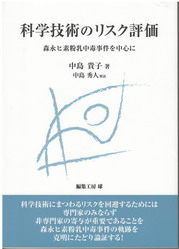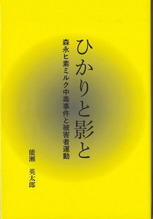森永ヒ素ミルク中毒事件の教訓と
直面する課題について 【アーカイブ】
【新刊紹介】
森永ヒ素ミルク事件の画期的通史。[分析期間: 1950-1974]
日本の科学史研究の第一人者で、惜しまれながら他界した故・中島貴子氏の著作が刊行された。

タイトルは『科学技術のリスク評価 森永ヒ素粉乳中毒事件を中心に』(編集工房球)であり、解説は、夫である中島秀人氏だ。ちなみに秀人氏は、『ロバート・フック ニュートンに消された男』で1997年度の大沸次郎賞を受賞するなど、日本の科学技術史研究の第一人者である。
本書は「科学と社会」のかかわり方を追求する「科学技術社会論(STS)」(参照→RISTEX)というテーマに取り組んて来た中島貴子氏の研究の集大成であるが、これを的確に解説するのは私には手に余る。
だが、私流のつたない解釈では、福島第一原発事故や、御巣鷹山の航空機事故、さらにはカネミ油症、シンドラーエレベーター事故など、科学と技術がからむ様々なインシデント[事件・事故などの事象]に関して、これまで科学・技術者がそれに対して取った態度が果たして妥当なものであったか、政治や経済との力学から、専門知がどのように展開され、またどのように歪められた可能性があるか、などを検証し、後世への教訓にするというものであろうと考える。
これは、テクノロジーに濃厚に支配されたこの人間社会のなかでは、きわめて重要なテーマであり誰もが避けて通れない道だ。氏も森永ヒ素ミルク中毒事件を中心に据えながら、上記のテーマに関する数々の研究に情熱を注いでこられた。帯に記載の文章からも想像できると思う。
「科学技術にまつわるリスクを回避するためには専門家のみならず非専門家の寄与が重要であることを森永ヒ素粉乳中毒事件の軌跡を克明にたどり論証する!」
この「非専門家」とは、問題に関与し、問題を取り巻く人々だが、心ある市民のほかにも、善意であっても科学分野への「思い込み」にとらわれている関係者や、知識の不足している人々も含まれている。また逆に、非専門家であても、専門家の陥穽を突き、それを乗り越える役割を発揮する人々も多い。
「専門家ばやり」の昨今、心に重くささる言葉だ。科学や技術の力と、それへの誤った幻想に基づく「専門知」がもたらした問題について、素人が読んでも目の覚めるような指摘が行われている。
ただし、著者自らが書くように、本書の分析の期間は「ひかり協会」の誕生までである。「1950年から1974年までを分析の対象時期とする」としている。それ以降の「ひかり協会」の大掛かりな変質と特定党派の介入を含めた現在に至るまでの異常事態は、能瀬英太郎氏の近著『ひかりと影と 森永ヒ素ミルク中毒事件と被害者運動』が担当している。
森永ヒ素ミルク中毒事件史を科学者が追跡すると現代に鮮明な教訓がよみがえる。
本書は、冒頭、「科学の不定性」というテーマから入る学術書であるが、まったく難解ではない。冒頭から事件の経過に導入される。最初のテーマ設定以降に、実証的に展開されているのは、森永ヒ素ミルク中毒事件の闘争史そのものである。
しかもきわめて詳細かつ具体的に記述されている。巻末には詳細な年表と登場人物の人名録まである。これは従来なかった事件史の切り口を示している。氏の読み込まれた膨大な文献量、全国を足で歩いて旺盛に渉猟された一次資料の規模には驚愕するしかない。氏は、犠牲者への深い哀悼の気持ちを胸に秘めつつ、その明晰な頭脳を冷静に駆使し、問題の核心部分を、ひとつひとつ容赦なく抽出し、暴きだしていく。
この研究書は、最新のSTSの分野でも第一級の水準であると同時に、森永ヒ素ミルク中毒事件の歴史についても正確で科学的な知見を現代のわれわれに与えてくれる。
戦後日本最初の食品公害事件を最先端の分析手法で解釈しなおしたという意味で、大胆に申し上げるなら、全国民必読の書だ。すくなくとも、例えば、原子力や薬害、食品、環境汚染、医療政策、差別政策、隔離政策など、政治と科学と人間への棄損行為の関連性に関心がある人々、そして社会と人間とのよりより関係を模索する科学・技術者には、必須の知見を与えてくれる書籍である。
【ご注文】お近くの書店、もしくはAmazon等でも注文できる。
───────────────
【新刊】新刊書『ひかりと影と 森永ヒ素ミルク中毒事件と被害者運動』(第1回)

書籍のご注文は、著者である能瀬英太郎氏へ直接連絡願います。
〒700-0945 岡山市南区米倉157-17 電話 086-241-1255
お申込はメールか電話で。
メール e-nose■taupe.plala.or.jp [ ■ をアットマークに変更]
送料込みで1冊1800円 お支払いは振込(書籍郵送時に振込先同封)
なお、同書は、森永ヒ素ミルク中毒事件資料館でも取り扱い中です。
〒700-0811 岡山市北区番町1-10-30 森永ヒ素ミルク中毒事件資料館/岡崎久弥
お申込はメールで。
メール kotou826■yahoo.co.jp [ ■ をアットマークに変更]
送料込みで1冊1900円 お支払いは郵便振込(書籍郵送時に振込先同封)
■学術論文 1.
「森永ヒ素ミルク中毒事件50年目の課題」著者:中島貴子
http://shakai-gijutsu.org/vol3/3_90.pdf (PDF:82.3KB)
社会技術研究会 J-STAGE : 社会技術研究論文集
中島貴子氏 略歴 ---
独立行政法人 科学技術振興機構所管の、社会技術研究開発センター研究員、東京大学大学院
法学政治学研究科21世紀COEプログラム 特任研究員を歴任。
近年、下記のような、注目すべき論文を次々に発表している。
■学術論文 2.
『食品安全をめぐるディスコミュニケーション
―食品安全委員会への提言―』
https://www.jstage.jst.go.jp/article/sociotechnica/2/0/2_0_321/_article
(PDF:82.3KB)
(J-STAGE : 社会技術研究論文集)
社会技術研究システム・ミッションプログラム
「安全性に係わる社会問題解決のための知識体系の構築」の研究として実施。
■学術論文 3.
『事故調査と安全確保のための法システム
Ⅰ 事故調査・情報収集分析体制の在り方
事故調査と被害者救済---個別事例の観点から』
(Jurist ジュリスト誌特集論文 2006年発表をご参照ください)
■学術論文 4.
『公害事件における無視型リスクと専門家の倫理
―リスクガバナンスの観点から―』(2008年)
■学術論文 5.
『科学的知見の不確実性と専門家の倫理
―戦後日本の食品事件を例として―』(2007年)
http://repo.lib.nitech.ac.jp/bitstream/123456789/3675/1/grknit2007_51.pdf
■学術論文 6.
「食品のリスク評価と専門知の陥穽に関する歴史的考察
─森永ヒ素ミルク中毒事件を中心に」著者:中島貴子
『日本の科学者』2007年5月1日発行版 掲載論文(PDF:3,700KB)
「森永ヒ素ミルク中毒事件には、医学や法律の専門知がリスク評価を誤り、事態を混乱させ、被害者救済を遅らせた側面がある。この側面は、リスク評価の対象や方法の選択を特定分野の専門家に独占させず、消費者保護を最優先に考える幅広い専門家に解放する必要と、専門家と一般市民の協同作業の有効性を吟味する必要を示している。」 (同論文リードより)
(随時追加していきます)
【疫学論文】
森永砒素ミルク中毒に関する疫学調査:瀬野地区における広大・岡大合同検診最終報告
(日本衛生学雑誌/1972)
Epidemiological Studies on the Morinaga Powdered Milk Poisoning Incident ※本文は日本語です
https://www.jstage.jst.go.jp/article/jjh1946/27/6/27_6_500/_pdf
【抄録】
In 1955, many babies who had drunk arsenic-tainted milk produced at the
Tokushima Plant of the Morinaga Milk-Industry Company Ltd., suffered from
serious poisoning. The number of victims ascertained in February, 1956 covering
27 prefectures in the western part of Japan was 12, 159, of whom 131
died.
The disaster was caused by the process of manufacturing the powdered
milk. Disodium phosphate was added as a stabilizer to make the milk easily
soluble. This disodium phosphate was poorly purified, intended for non-food
industrial use, and contained a toxic dose of arsenic, sodium arsenite and
vanadium compounds etc.
Shortly after the disaster, numerous medical reports
were published. A committee organized by the Society for Child Health (the
chairman was Prof. Nishizawa of Osaka University; so it was called the Nishizawa
Committee), determined criteria for the diagnosis of the poisoning; but these
criteria were inadequate and erroneous from several points of view. Strange to
say, debates and publications about the disaster disappeared quickly after the
report was published by the Health Department of Okayama Prefecture stating that
the victims had recovered completely according to the criteria established by
the Nishizawa Committee only one year after the disaster.
Until 1969, when
Prof. Maruyama et al., of Osaka University reported on victims whom they had
visited, no study had been made to ascertain whether or not there were any
after-effects of the poisoning. Much fault must be found with the Ministry of
Health and Welfare, with the attitude of the Morinaga Company, and with the
doctors concerned, for this neglect to follow-up such an unprecedented and
large-scale disaster.
In 1969, the authors managed to organize an
epidemiological study group with several departments of Hiroshima University and
the Department of Hygiene of Okayama University cooperating and have developed
joint research on this disaster as follows:
1. A follow-up survey was made
among victims in Okayama Prefecture between December 1969 and April 1970. 214
people answered the questionnaire and 74 were given a medical examination.
2.
A prospective study was made on the basis of a questionnaire on clnical
complaints collected at the time of the disaster in 1955.
3. A comparative
study was performed between the victims and their brothers and sisters.
4. A
comparative study was performed among handicapped children in institutions in
Okayama Prefecture, who were born between January 1st, 1953 and December 31st,
1955. The children were divided into three groups, namely those who had consumed
the arsenic-tainted milk, those who were brought up on different brands of
powdered milk from different companies, and those fed only maternal milk.
5.
A comparative study was performed among all children born between January 1st,
1954 and December 31st, 1955 and brought up in Seno district in Hiroshima
Prefecture which has a relatively stationary population and where good records
had been kept of the physical growth and mental development of the children in
the nursery, primary and junior high schools. The children were divided into the
same three groups as mentioned above. This study was performed as a joint
research project by the Departments of Public Health (Director: Prof. M.
Tanaka), Orthopedics (Director: Prof. K. Tsuge), Ophthalmology (Director: Prof.
T. Dodo) and Psychiatry and Neurology (Director: Prof. K. Sarai) of Hiroshima
University Medical School and Deparment of Conservative Dentistry (Director:
Prof. T. Inoue) of Hiroshima University Dental School, and Department of Hygiene
(Director: Prof. M. Ohira) of Okayama University Medical School. All clinical
examinations were conducted separately under the double blind method.
6. The
124 cases of the children examined in the district of Senogawa town were
discussed individually by the six medical doctors and five dentists who did the
examinations.
https://www.jstage.jst.go.jp/article/jjh1946/27/6/27_6_500/_article
Distinguished Alumnus Award 2010
2010 Recipients
Hideyasu Aoyama, SPH '69
Hideyasu Aoyama managed the directors of every preventive medicine department in all of Japan's medical schools prior to his retirement in 2003, including Okayama University Medical School and Kochi Women’s University, the premier Japanese women's institute for nursing and health. He has been an outspoken voice for worker safety, pushing to discover the etiology of the disease subacute myelo-optic neuropathy (SMON), a neurologic disease resulting from exposure to the drug clioquinol, which was associated with two epidemics in Okayama. He was among the few public health physicians who worked to establish the industrial origins of an outbreak of arsenic poisoning among Japanese children and to continue to bring public pressure upon the company that was responsible. His work eventually led to long-term treatment and care for survivors of the epidemic. Hideyasu has also been decorated with a number of nationally based awards in Japan as well as election to the Johns Hopkins Society of Scholars. In February 1999, he was elected to the Bloomberg School's Dean's Alumni Advisory Council. Hideyasu has brought a global perspective to the practice of public health in Japan. Within one year of his graduation from the Bloomberg School he helped to set up a fellowship program for non-Japanese physicians coming to Japan. He reinforced his beliefs in cultural exchange and international scholarship in May 2002 when he endowed the Aoyama-Kita Scholarship at the Bloomberg School of Public Health, which has granted funding to students every year since its founding.
Johns Hopkins Alumnus Distinguished Alumnus Award 2010から引用
【関連サイト】
社会技術研究開発センター(RISTEX)
Research Institute Science and Technology Society
>>>独立行政法人 科学技術振興機構
(随時追加していきます)
参考ページ
学術論文Ⅱ
デジタルアーカイブ コーナー
![]() トップページへ戻る
トップページへ戻る